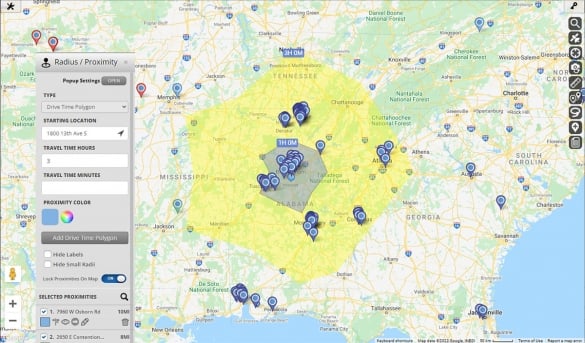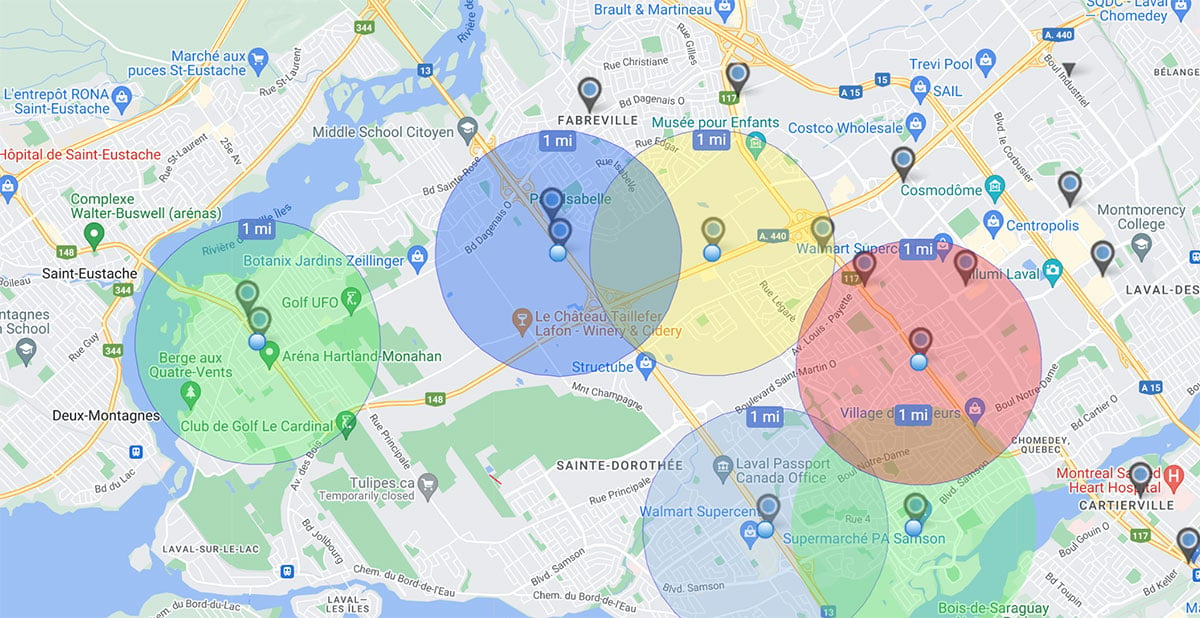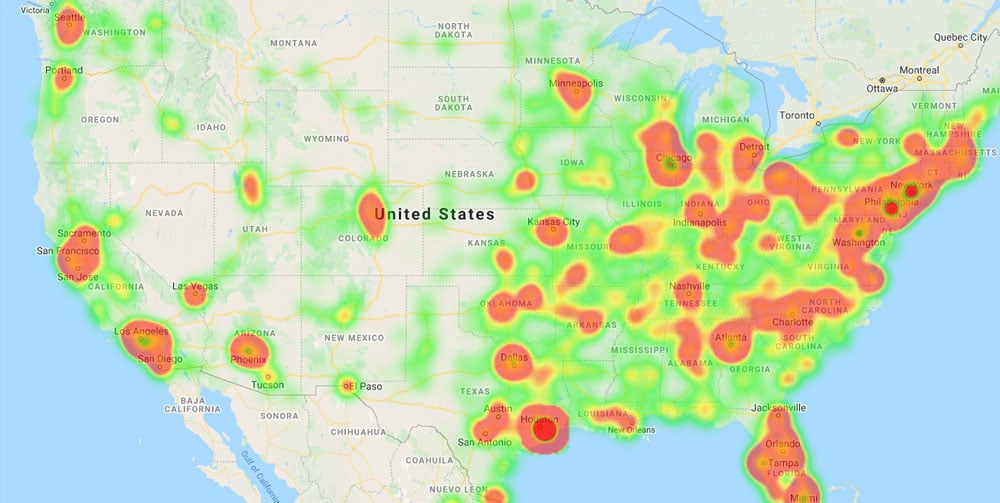
Selecting a new site for your business? Don’t brush off the saying “location, location, location” as a cliché in real estate. Where you set up shop can seriously impact your ability to cut costs, steer clear of risks, attract employees (and customers, especially in retail), and expand your business. Your chosen location isn’t just a formality; it plays a crucial role in shaping the success of your enterprise.
According to data from the US Census Bureau, on average, there are 4.7 million new businesses started every year–and in 2023, retailers across the United States were expected to open 1,000 net new stores, which means that commercial real estate is in high demand and that retail space availability has reached record lows.
So, if you are one of the over 5 million entrepreneurs who launched a new venture in 2023, you might be about to enter a bidding war for the best business locations available. But before you succumb to the allure of any overhyped location, remember that there’s more to selecting a business location than just an attractive lease in a buzzworthy zip code. Your site selection process must consider a range of factors to give you the best shot possible at success:
And more.
Learn about the factors and principles of site selection, how to choose a business site selection successfully, and how Maptive’s robust GIS mapping software can streamline the site selection process.
Table of Contents

Site selection is the process of combining financial, demographic, and geospatial research and analysis to choose the optimal location for your business.
Why is it important? Historical data from the US Small Business Administration indicates that about 70% of new businesses survive beyond two years, 50% beyond five years, 30% beyond ten years, and 25% beyond fifteen years. With those odds, selecting the right retail location might be the deciding factor between launching a successful enterprise or becoming a cautionary tale.
That’s why you should consider more than just downtown storefronts and strip malls–instead, explore a variety of options, including airports, free-standing buildings, and special event kiosks. This process, often conducted alongside catchment area analysis, involves strategically placing stores in optimal and densely-populated locations tailored to your target market demographics. A key aspect of retail site selection is a thorough examination of competitor locations, as their proximity can significantly influence success in the chosen area.
Industrial Site: Manufacturing or distribution businesses with unique needs should explore industrial sites, especially if large warehousing space, access to major transportation routes, or specific environmental considerations are critical to the operation.
Corporate Site Selection: If you are establishing an office or headquarters as a growth center, focus on identifying financially friendly and well-connected areas with a thriving workforce. The key is to achieve a delicate balance between low risk, minimal costs, and maximizing growth opportunities. The success of this selection hinges on finding a location that not only supports the current needs of the business but also facilitates long-term sustainability and expansion.
Retail Space: Businesses that rely on high foot traffic and easy need to strategically place stores in optimal and densely-populated locations tailored to your target market demographics. A key aspect of retail site selection is a thorough examination of competitor locations, as their proximity can significantly influence success in the chosen area. On the other hand, some businesses may need a physical presence while most of their sales are done online–and for them, commercial business spaces offer an ideal solution without requiring too much research for the site itself.
Mobile Business: Mobile card readers have multiplied the opportunities for small businesses to secure payments without a permanent retail store presence. Vendors at local markets, independent food trucks, and seasonal pop-up stores can all expand their reach with strategic site selection.
Home-Based Business: While running a business from your home has been thankfully normalized, sometimes your home office, garage, or basement might simply not be enough. If you want to keep working from home but require more space, you might want to consider moving into a bigger property, or–if you have the land and local regulations permit it–you might want to expand your existing home to create the necessary space.
In site selection, research is everything. The more valuable data you have, the smarter, more-informed business location decisions you can make.
However, research alone can quickly become abstract. And the massive volumes of spreadsheet data you’ll need for sound decision-making can be very overwhelming.
That’s why most teams conducting business site selection trust GIS software like Maptive to transform their troves of business location data into practical, intuitive, and actionable data visualization maps in seconds. Try Maptive free for 10 days.
Site selection without the guidance of principles is rudderless—and puts your business at risk of inefficiency, unnecessary expenses, and damaging decisions. Trust these five principles:
Data mapping can help you easily extract a shortlist of high-upside potential business locations. And Maptive’s wide range of powerful features can help you hone in on your best choice. Schedule your free live demo to get guidance, tips, and tricks on site selection for your business.

There’s no substitution for a clear process. Here’s how to choose a business location, from initial steps and what to research all the way through getting the best out of your data.
When it comes to picking a spot for your business, there’s too much at play to tackle it solo. Round up a crew for your site selection team—grab folks from your executive, operations, HR, and financial squads. Heck, throw in some site selection consultants if you think they’ll help.
Take, for instance, a retail store. You’d want a marketing manager on your site selection team to dig into customer demographics and shopping habits. It’s all about making the decision with a mix of perspectives to get it just right.
Articulate the purpose of your new business site. Determine whether it will serve as a retail or corporate location and establish key parameters, including budget considerations. Develop clear criteria for measuring the success of the chosen site.
For instance, consider a coffee shop seeking a location in a high-traffic area, while a manufacturing plant might prioritize proximity to efficient transportation and utilities. Customize your site selection criteria to align with the specific goals of your business.
Once you have your criteria in place, collect initial data. Internal business data, external commercial real estate data, and United States Census and Demographics data—available to you in an instant with Maptive—each give your site selection map valuable depth. Then, use Maptive’s Filter Tool to hone in on your ideal target areas.
This strategic use of data and mapping tools ensures a comprehensive and well-informed site selection process.
Now that you have target areas in mind, conduct comprehensive research on every important factor that may impact a site’s viability. Collect data on:
For instance, when choosing a location, a distribution center might take into account factors like proximity to suppliers and transportation costs, ensuring a comprehensive evaluation tailored to their specific needs.
Easily integrate your data from various sources—whether it’s an Excel spreadsheet, Google Sheet, CRM, or other .CSV files—into Maptive. The software streamlines the heavy lifting and analysis, facilitating a swift decision-making process. Maptive simplifies the selection of your top choices, allowing you to make informed decisions within minutes.
Visit your best potential site selections, conduct due diligence, make a decision, and negotiate your lease or purchase price. You now have your brand new business location!
And remember: location is important, but so is timing. If you are opening a retail location, you’ll definitely want to visit potential locations during peak hours to gauge customer traffic and assess parking availability. The same principle applies to corporate real estate: make an effort to commute to and from any prospective new location during different times of the day. This hands-on approach ensures that your business not only benefits from a strategically positioned site but also operates seamlessly within the rhythm of its surroundings.
While the selection process is far from easy, Maptive helps businesses choose office locations by making the most tedious and time-consuming steps as simple as a click of a button. Ready to choose your business location? Start your free, no-risk 10-day trial of Maptive now.
Wholesale & Distribution: supply chain logistics between distribution centers, suppliers, and clients.
Real Estate: current market conditions and outlook, rental occupancy rates, real estate sales figures, and street-by-street insights for real estate brokers
Private Infrastructure: existing electric, fiber optics, water and sewer systems, and government contracts and spending data.
Airports: local domestic and international travel statistics, regional competition, access to interstates and major highways, and airline networks.
Restaurant Chains & Retailers: local business climate, labor availability, access to suppliers, and local taxes.
Want to gain insight on factors specific to your business and industry? Brainstorm ideas and learn solutions with our rockstar support team. Schedule your live demo now.

For most businesses, your virtual storefront is just as important as your physical store. In fact, research shows that 76% of consumers look at your online presence before physically visiting a business. To give people a reason to choose your business both online and in-store you should strive to be easy to find and engaging enough to build real connections.
Here’s why:
Vice-versa, where you set up your physical shop might influence your online reputation. If you’re nestled in a safe, friendly neighborhood, people will be less likely to have negative experiences getting to your shop or waiting for their table.
Plus, if you do a lot of online orders or deliveries, you should consider setting up shop somewhere with easy access to couriers and transportation routes.
With its industry-leading range of enterprise-level and user-friendly features, Maptive makes it easy to choose your best business location possible. Here are some (of many) examples.
Your site selection map should be rich with layers of important data. However, that poses another question: how can you intuitively read so much information? With Maptive’s Grouping Tools: simply color and customize your markers by category, then filter them for easy retrieval.
No business location map is complete without demographic data. With Maptive, you get instant access to the latest U.S. Census Demographic Data, so you can get deeper insights into your chosen location’s population density, median household income, education, and more.
With hot spot heat maps available at your fingertips, you can identify where you’re succeeding—and where you need to open locations. All from your spreadsheet data. Visualize and track your concentrations of data, identify hot spots, and discover your cold spots.
A bad weather system can set your business back in an instant. Business-shattering factors can creep up on you with climate change. Identify geographic and environmental risks easily with rich satellite imagery sourced via Google Maps.
When it comes to employees, customers, and delivery trucks, time and stress behind the wheel can have an outsized impact on your bottom line. Maptive’s dynamic duo of driving intelligence tools—the Driving Radius Maps and Drive Time Polygon Tools—can help you track how far you can reach, where you can go, and where your business should be—with real-time data.
Start your free, no-risk 10 day trial of Maptive today.
No credit card required.
Brad Crisp is the CEO at Maptive.com, based in Denver, CO and born in San Francisco, CA. He has extensive experience in Business Mapping, GIS, Data Visualization, Mapping Data Analytics and all forms of software development. His career includes Software Development and Venture Capital dating back to 1998 at businesses like Maptive, GlobalMojo (now Giving Assistant), KPG Ventures, Loopnet, NextCard, and Banking.
